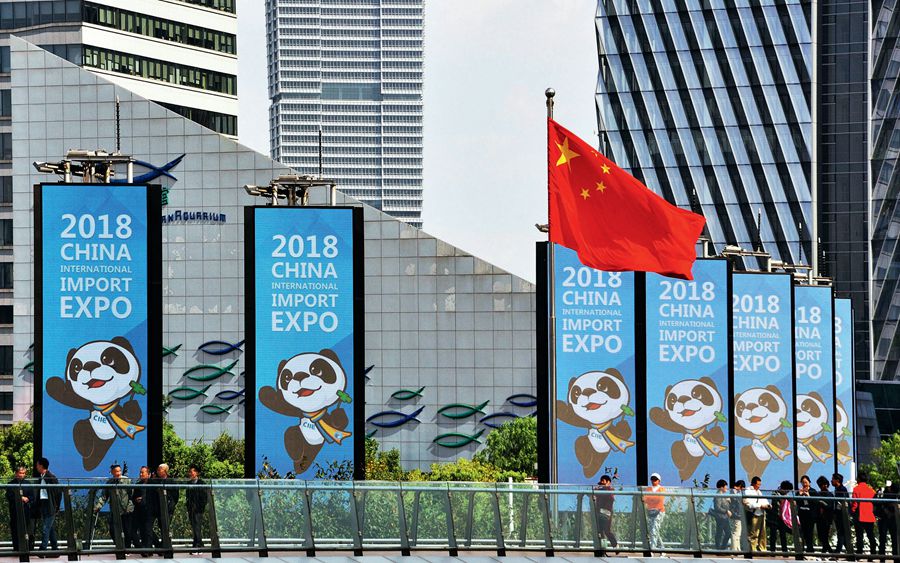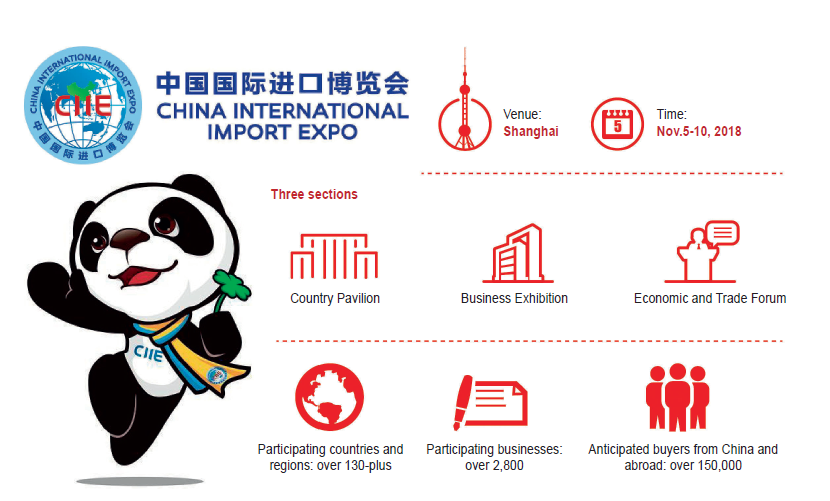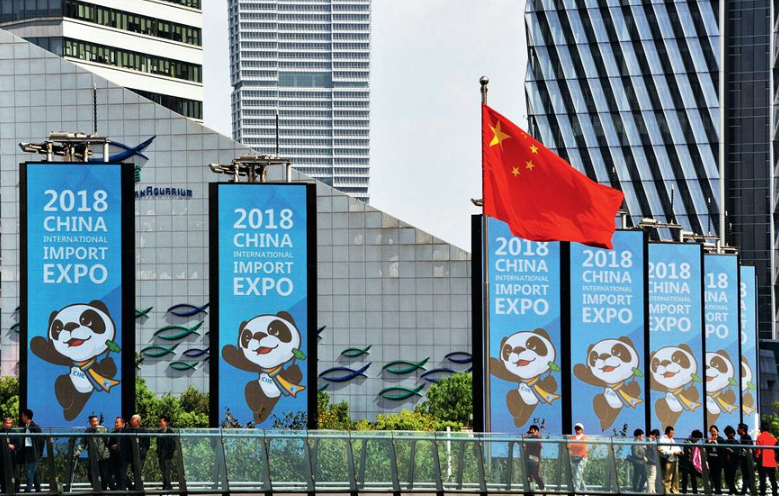Chinese President Xi Jinping announced at the Belt and Road Forum for International Cooperation in May 2017 that China would hold the first import expo in 2018. Hosted by the Ministry of Commerce and the municipal government of Shanghai, this annual event opens its first session on November 5 at the National Exhibition and Convention Center in Shanghai.
This expo is expected to provide an open platform for cooperation where countries from around the world exhibit the achievements of their development and conduct international trade. It is of great significance for China to host such an event during a time of surging unilateralism and trade protectionism, which impose a grim threat to the world multilateral trade system.
Opening-up at a Higher Level
While addressing the Boao Forum for Asia Annual Conference 2018 in April, President Xi called the China International Import Expo (CIIE) a big platform, and said that China will host it every year. It is not a generic expo, but a “major policy initiative and commitment taken of our own accord to open up the Chinese market,” he added.

CIIE billiboards at the Oriental Pearl Radio & TV Tower in Shanghai.
The expo is expected to herald a new round of opening-up at a higher level. Since the start of this year, President Xi has announced a number of major measures to expand opening-up, increasing imports being a key facet of them. New policies have been introduced to expand imports, and some are showing early results. For instance, China slashed tariffs on 1,500 consumer goods, among which the rate for imported cars has been lowered from 25 percent to 15 percent, and that for 28 anti-cancer drugs is now zero. It further reduced tariffs on 1,585 imported products starting November 1 of this year, bringing down China’s overall tariff rate to 7.5 percent from 9.8 percent of last year.
Looking back at the 40 years of reform and opening-up, we can see that lowering tariffs and increasing imports is the requirement for China’s economic development and opening-up. As a major step China takes in support of free trade and economic globalization, and to open its market wider to the rest of the world, the CIIE will facilitate the country’s measures to increase imports to yield real results, and advance its new round of opening-up to a higher level.
High-Quality Development
The Chinese economy has shifted gears from high-speed growth to high-quality development. For this purpose China has introduced supply-side structural reform, and is working to improve both the quality and efficiency of its economic development. Increasing imports will give a strong boost to both.
For four decades, China’s economic growth has been primarily driven by exports, investment, and consumption. For a time, exports of goods and services accounted for nearly 40 percent of China’s GDP. Under economic restructuring and upgrading in recent years, consumption is now the leading driver of economic growth, amounting to 53.6 percent of GDP last year with its contribution to economic growth rising to 58.8 percent. In the coming years, China will pay more attention to balanced development of its imports and exports and to the role of domestic consumption in driving economic growth. By increasing imports, China can make international allocation of resources more rational and effective, improve its supply structure and the quality of its supply system, advance industrial restructuring and consumption structure upgrading, boost policy innovation, create a better business environment, and establish a modern economic system.

China is working to reach the goal of building a moderately prosperous society in all respects in the coming years. Chinese people’s material and cultural needs have grown, as is seen in the soaring demand for high-quality commodities from all over the world. According to the World Tourism Organization, Chinese people forked out US $258 billion in their trips abroad in 2017, which accounted for 20 percent of all tourists’ spending worldwide for the year, with US $99.8 billion of the sum going to shopping. The CIIE brings foreign goods to the doorsteps of Chinese consumers, offering them more options in shopping and meets their increasingly diversified needs.
Building an Open World Economy
China is now the world’s second largest economy and a leading trader. With its contribution to global economic growth exceeding 30 percent for years, it is a major stabilizer and driver of the world’s economy. According to the whitepaper China and the WTO released by the State Council Information Office in June, China is projected to import US $24 trillion worth of goods in the coming 15 years, more than the total imports of the past 40 years (US $21.8 trillion) since the country started reform and opening-up.
The CIIE is an open platform where products from all over the world are bought and sold. It signifies China’s support for the multilateral trade system and free trade, the stance it has always adhered to, its opposition to protectionism, and its intention to build and safeguard an open world economy. By facilitating the entry of foreign goods and services into China, the expo is a substantive effort by China to fulfill its obligation as a major country to promote the construction of an open world economy, and will effectively boost free trade globally by creating new demands and dynamics.
With support from the WTO, the United Nations Conference on Trade and Development (UNCTAD), and the United Nations Industrial Development Organization (UNIDO), the first CIIE has received broad attention internationally. A dozen heads of state, leaders of governments, and hundreds of senior officials and corporate executives will be attending. At the Hongqiao International Economic and Trade Forum, which will be held during the expo, officials, scholars, and entrepreneurs will discuss issues of opening-up and win-win cooperation to seek common development, pool their wisdom to solve the problems facing all humankind, and build consensus to support free trade and economic globalization.
Boosting International Trade
The CIIE is the world’s first expo dedicated to imports, whose exhibits are entirely imported. It intends to bring together first-class manufacturers, products, and services from across the world, create a first-class environment for exhibitors and visitors, and deliver exceptional results for boosting international trade.
The first CIIE includes an overall exhibition of trade and investment and seven enterprise and business exhibitions. The sprawling space of 300,000 square meters is divided into sections for trade in services, automobiles, high-end smart equipment, consumer electronics & appliances, apparel, accessories & consumer goods, medical equipment & health care products, and food & agricultural products. On display are some of the most representative and highest quality products of different countries and regions as well as more than 100 new products and new technologies, which showcase the most advanced level and latest trends of goods and services globally.
According to statistics, 80 countries and 2,800-plus businesses from 130 countries and regions have confirmed participation. Among them are more than 200 world top 500 companies and standard bearers in their respective industries, all G20 members, 50-plus countries and regions along the Belt and Road, and 30 least developed countries, which stand for broad representation. More than 150,000 corporate buyers are estimated to show up. The exhibitors hope the event will help them explore more marketing channels and build contacts with more business partners, thereby optimizing their presence in the Chinese market as well as other markets worldwide.
To ensure the best results, the organizer provides a variety of facilitation services, such as in the fields of customs clearance, inspection and quarantine, and protection of intellectual property rights. A service center will be set up at the expo to protect intellectual property rights, handle business disputes, and provide relevant legal services. All these measures will contribute to the CIIE’s goal of being a key platform for global trade.
YAO LING is deputy chief and research fellow of the Department of European Studies at the Chinese Academy of International Trade and Economic Cooperation.



